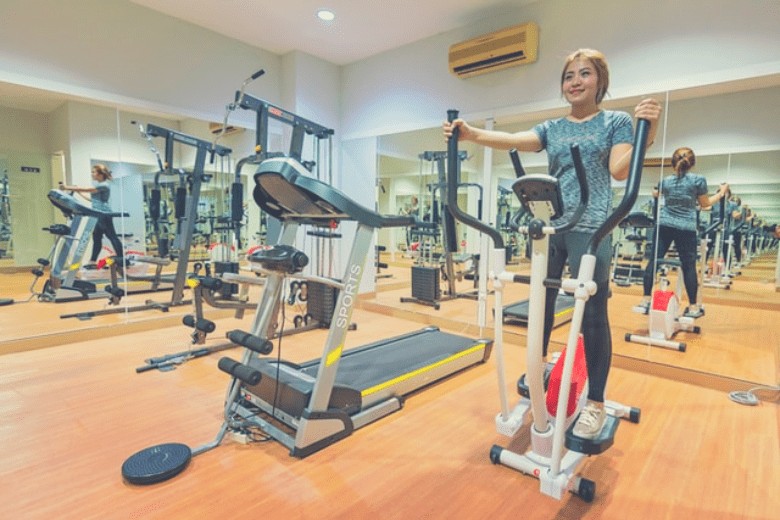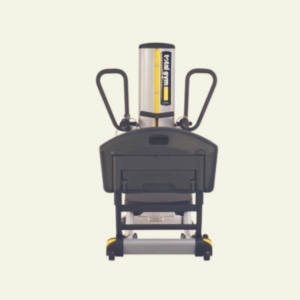Cardio or cardiorespiratory exercise is defined as movement that trains and improves your heart and lung function.
Everyone should perform this type of exercise — whether you’re a sixteen year old weightlifter, or a retired senior citizen.
However, the way you go about doing your cardio is just as important.
This can leave you wondering — is too much cardio a bad thing for your body?
Therefore, continue reading to learn this and how to implement cardio in a healthy and safe way for your unique body type!
What Activities Count as Cardio?
Cardio is classified as any exercise that elevates your heart rate while also improving the lungs and circulatory system.
This means that it has to be somewhat challenging.
You don’t necessarily have to be out of breath every time you perform cardio. However, a simple stroll from your workstation to the coffee room is definitely not cardio either, even if it raises your heart rate by a few more beats per minute.
On average, you should be getting 30 minutes of anaerobic exercise daily.
Cardio is also not as limited as most people think. You don’t have to run on a treadmill for hours to meet your cardio requirement for the day.
Examples of cardio-heavy activities include the following.
Rowing
Many people often forget that rowing is an incredible way to increase your heart rate, burn calories, lose weight, and sculpt a killer upper body.
You can find this cardio machine at most commercial gyms.
Buying your own machine for at-home use isn’t out of the question either.
Out of all the cardio-centered machines you can buy, rowing machines are typically the most affordable ones.
Rowing consistently also works out the biceps, the latissimus dorsi — and get this — the core too!
You can burn up to 1000 calories in a single hour long workout, which makes rowing the supreme exercise for cardio and upper body training.
Swimming
Swimming is one of the most low-impact forms of cardio you can do.
But that’s not to say that it’s not effective.
Since you’re submerged in water, your joints and bones will not feel the brute force they usually experience when doing other forms of cardio training.
Circuit Training
Circuit training may be one of the most powerful forms of cardio.
The reason being, is that you have a lot of freedom when designing a cardio-based circuit.
A circuit is defined as a repetitive set of exercises that’s meant to keep your heart rate high.
There are minimal breaks. In fact, you should not rest until the cycle of the circuit has been completed!
You can incorporate four to five of the following exercises together to create your own circuit.
- jumping squats
- burpees
- 30 seconds of sprints
- Russian twists
- 30 seconds of jumping rope
- bicep curls
- walking lunges
- medicine ball slams
After doing five of these exercises back to back, rest for 60 seconds and perform the circuit for five more sessions.
Elliptical Training

Elliptical training is gentle on the body. It’s an excellent form of cardio for the elderly, beginners, or anyone who is overweight.
Additionally, this machine also works the upper and lower body simultaneously.
Jumping Rope
This form of cardio is dirt cheap, but can still help whip your body into astounding shape.
It can cost anywhere from ten to fifteen dollars.
The weighted ropes are a bit pricier, but these aren’t necessary if you’re first starting to incorporate more cardio into your fitness regimen.
If you’re looking to save on a gym membership, paying this upfront can save you so much money throughout the year.
Running
Running is what most typically imagine when someone says the word ‘cardio’. However, not everyone enjoys the activity.
Afterall, it’s incredibly strenuous and taxing on the body. It’s also mentally challenging. Sprinting on a treadmill at full speed for a measly minute will seem like an eternity!
However, running can also push you out of your comfort zone.
Running is also free!
You don’t need a treadmill with all of the fancy settings. Do your cardio the old-school way and run around your neighborhood.
A typical run can burn anywhere from 100 calories per mile.
Biking
Bike indoors or outdoors!
The choice is yours.
Cycling is a fantastic way to get your cardio in for the day.
You can bike to work and complete two tasks simultaneously.
Biking can also jack your heart rate up since you’re constantly moving.
Stair Climbing
If none of these cardio modalities are calling your name, consider hopping aboard the stairmaster for your next cardio workout.
This machine looks like a stationary set of stairs. It also challenges and engages your gluteus maximus and quadriceps to a new degree.
So Is Too Much Cardio a Bad Thing?
Now that you’re aware of different styles of cardio you can do, this raises another point. Will doing these activities too often harm my body in the long run?
The answer is complex, as everyone’s body and need for activity is different.
For someone who is overweight, performing low impact, steady cardio five times a week is beneficial.
It’s also a quick way to burn calories and shed excess fat.
However, for someone who is a bit older or suffers from knee pain, excessive cardio on the treadmill can be detrimental to their health as it can wear down the cartilage in their knees.
So, in this case — yes — doing excessive cardio is bad for your body. It can leave you and your body feeling exhausted if you’re going on multiple runs every single day .
Another reason that cardio can be bad for your health?
Cardio is not a weight bearing exercise, which means that it does not strengthen your bones and joints like other forms of exercise can.
Too much cardio may not give you the body of your dreams.
Excessive cardio can lead to a ‘skinny-fat’ type body, which looks quite thin, but still has a poor muscle and fat distribution.
Lifting weights, on the other hand, can make your muscles bigger and improve your body’s composition.
Additionally, exercises like squats, deadlifts, and bench press also train other parts of your body such as your bones, joints, and even your core.
The bottom line is that cardio should not take priority over strength training. They should be used in tandem if you want to achieve a fitter and healthier body.
Running every single day for long distances can take its toll on you and cause wear and tear on the body.
Proper rest days in between long distance sprints is also recommended.
Unless you’re training for a marathon or are an all star track athlete, you won’t have to subject yourself to heavy cardio sessions everyday.
It can be harmful, mentally and physically.
How Often You Should be Doing Cardio?
Performing intense cardio two to three times a week is optimal.
If you’re trying to lose weight, go for a run four to five times a week. However, also supplement your cardio with a weight training program.
For best results, find a balance of High-Intensity Interval Training (HIIT) and Low-Intensity Steady State (LISS) training.
They each have their own list of unique benefits and incorporating both (as well as weightlifting) will keep you on your toes.
How to Perform Cardio Safely
Aside from finding the right cardio for your body type, there are other ways to ensure you’re performing your cardio as safely and responsible as possible.
Drink Enough Water, During and After

You lose so much water when performing cardio!
Ensure you’re staying hydrated.
You want to drink 6 to 8 ounces every 20 minutes that you are active.
Don’t Hold on to the Sides of the Machine
Whether you’re on the stair climber or a treadmill, try not to grab onto the sides of the machine.
The exercise loses its effectiveness when you do this. You will also develop a false sense of security and balance, and your risk not engaging your core properly.
Lead With Your Chest
When you feel fatigued, it’s normal to let your chest and shoulders droop when you’re running.
However, if this does happen to you, slow your pace down and regain your breathing.
Stop completely if you need to. Running with your chest facing the ground can cause muscle and postural imbalances overtime.
Stay Light on Your Feet
You can also injure yourself if you’re running with flat feet since this can place excess pressure on the joints, bones, and muscles on your feet.
Make sure to stay on the balls of your feet instead, for an optimum running experience.
What to Consider When Using Cardio for Weight Loss
Cardio can be a valuable tool when you’re trying to lose weight.
However, if you abuse it, it can damage your body and not deliver the results that you’re hoping for.
You Can’t Outrun a Bad Diet
Try to think back to your last cardio session.
You completed an hour of intense running. You feel great, albeit a bit tired.
But your endorphins are high and this sense of accomplishment overtakes you.
You’re on the way home and realize you’re hungry — you automatically want to treat yourself with a tasty snack.
It may not be the healthiest food, like a cheeseburger or a muffin.
However, in your mind, you feel as if you’re earned it!
This thought process is common, but it’s not productive.
In actuality, those calories you just burnt off will go to waste and you won’t make any progress.
You’ll stay stagnant and frustrated.
Therefore, take your cardio seriously! Learn early on, that you can’t outrun a bad diet and meet all of your goals.

You Don’t Have to Hate Cardio
If you groan every time you realize it’s cardio day at the gym, this is a sign that you should switch things up!
The more you hate something, the more likely you are to skip the session.
Therefore, find a form of cardio that you absolutely love!
There are so many different types that will suit your lifestyle and current level of fitness.
Go outdoors and play soccer with the family!
Ride your bike through a local park.
Utilizing cardio for weight loss shouldn’t feel like pulling teeth.
Types of Cardio
There are two types of cardio in the world of fitness — HIIT or LISS.
If this is your first time hearing about these two distinct styles, not to worry. Here’s how you can perform each.
HIIT Cardio
HIIT cardio also stands for high intensity interval training.
Whenever a non-athlete like yourself wishes to lose fat while preserving their muscle mass, they opt for this style.
Since it’s rapid — a session takes 12 to 15 minutes — you can throw this after a weightlifting session for optimum gains without worrying about fatigue.
You can perform HIIT cardio on any of the machines previously listed.
It works by combining intervals of high and low intensity to place your body in an EPOC state, or an elevated post oxygen consumption state.
Your body will continue to burn calories throughout the day.
When performing this exercise, start with a warm up and cycle between intervals of resting and sprinting.
You should be at 90% of your maximum exertion when performing the peak periods.
This should last 30 seconds, before you phase back to the resting state. Move between these two cycles for the entire workout.
LISS Cardio
Low impact, steady state cardio is another style of cardio.
Your heart rate is a lot lower throughout this session, but it’s meant to be performed for a longer stretch of time.
LISS cardio should last somewhere between 45 to 60 minutes.
Keep a steady pace.
The elliptical machine is ideal for LISS cardio.
You can also walk on a treadmill at an incline for the full hour.
The incline of the machine will engage your glutes and core so that your body is working harder throughout the exercise.
Final Thoughts
In conclusion, cardio in moderation is extremely healthy for your body and mind.
However, since it can also place a lot of stress on the body, don’t go overboard!
Take rests and find a form of cardio you love, whether that’s swimming, or running around your neighborhood.
Cardio is essential, no matter what your fitness goals are, whether you want to lose weight or have more energy.
But keep in mind that if you’re trying to achieve these goals, cardio should be supplemental to a well-built weight training program for the best results.



